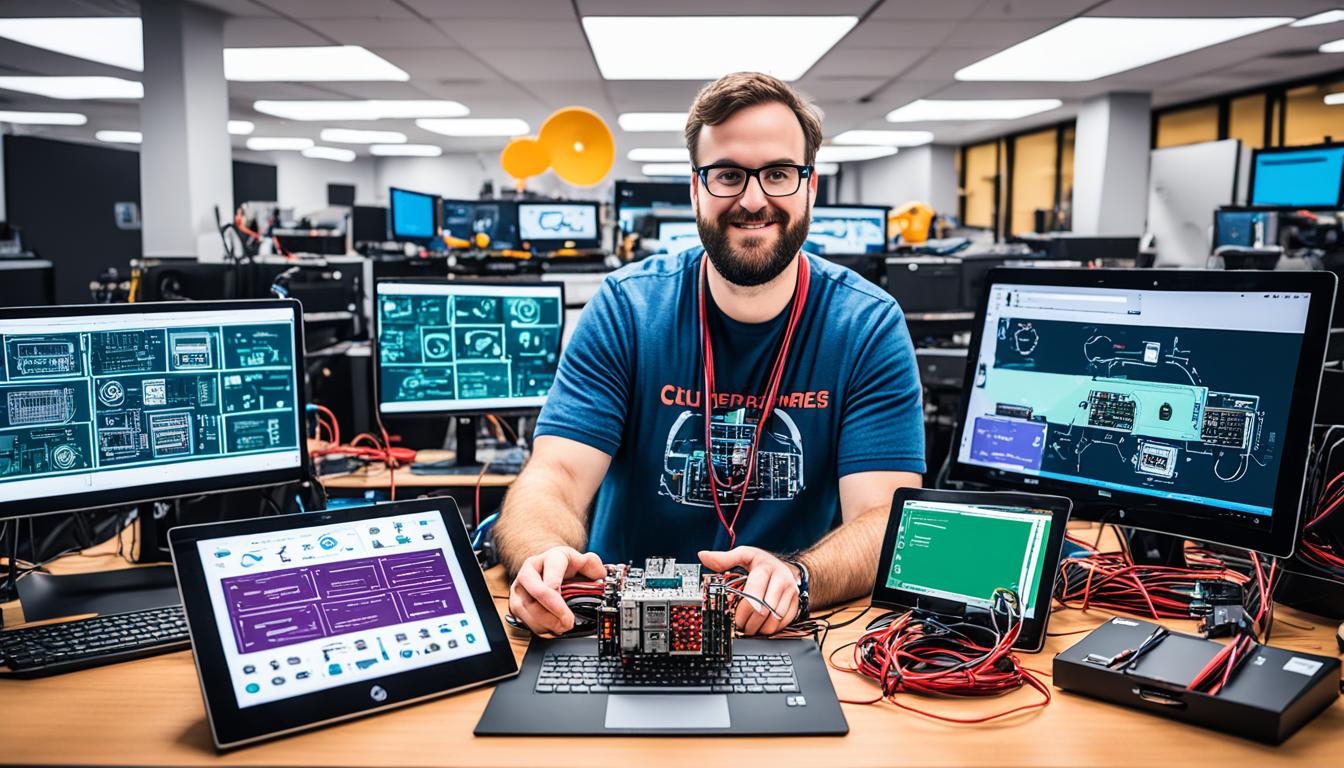In the latest Kubernetes Hackathon, every project won an award1. Showcasing talent, 19 winners emerged in various categories.
The “Best use of open source technology” was a winning theme1. Twilio, as a top sponsor, supported participants with resources1.
This hackathon was unique for its range of prizes. DevTool API offered the most rewards1. Also, Open Source Buddy received the most votes for their work1.
A project named Clock Chat revealed an inventive hidden homepage feature1. Tools like Datree and Devtron were key in creating advanced solutions1.
AI and voice assistants were the highlight technologies1. Community-focused apps proved to be the preferred project type1. This aligns with enhancing collaboration within Kubernetes.
About 60% of entries focused on tech advancements. The rest, 40%, aimed at social good1. Most projects developed were about improving DevOps tools.
Kubernetes hackathons are opportunities to innovate and grow. They are open to both new and seasoned developers. These events can be a career-changing adventure.
Key Takeaways:
- All projects at the recent hackathon won awards across varied categories1.
- Open source tech played a big role, with Twilio offering notable support1.
- Tools like Datree, Devtron, and Kubernetes were heavily utilized1.
- Projects mainly focused on AI and integrating it within the Kubernetes framework1.
- The event highlighted the value of collaboration and social impact projects1.
Look forward to more in this series. We’ll cover the benefits of joining a Kubernetes hackathon, suggest ideas for all skill levels, and present projects to boost your resume. Jump into the innovative world of Kubernetes with us!
The Benefits of Participating in a Kubernetes Hackathon
Joining a Kubernetes hackathon brings a lot of benefits for both teams and individuals. You get to show off what you’re good at and think creatively. Plus, you get to work with others who think like you in a fun and new setting2.
One big plus of a hackathon is learning new tech and getting real experience with it. Hackathons often showcase leading technologies like Kubernetes. This lets everyone try out these tools and see what they can do. By working on projects at the hackathon, you really get to understand new technologies and how they work2.
Hackathons are great for getting teams to work together and think out of the box. They bring people from different areas together to share ideas and come up with cool solutions. This helps get rid of any barriers in an organization and encourages everyone to work as a team2.
Also, hackathons can make the IT team look good within a company. When IT pros show their skills at hackathons, everyone sees the value they add. This can lead to more support and recognition for IT projects at work2.
Another plus is the chance to meet people in your field. Hackathons draw professionals from different places, making it easy to network. Meeting others in your industry can lead to great friendships and chances to work together in the future2.
There’s also the chance to win prizes at hackathons. Many offer rewards for the best projects, like financial support or access to special programs. These prizes can help you grow professionally and bring your projects to life2.
Overall, being part of a Kubernetes hackathon is a great opportunity. It’s a chance to learn, team up with others, show what you can do, and maybe even win something cool. Plus, it’s a way to encourage teamwork, creativity, and make new contacts. So, why not join a Kubernetes hackathon and see how far you can go2?
| Benefits of Participating in a Kubernetes Hackathon | Statistical Data Reference |
|---|---|
| Improved cross-team collaboration | 2 |
| Better creativity from engineers | 2 |
| Enhanced standing of IT within the business | 2 |
| Promotion of innovation within organizations | 2 |
| Educational benefits on new technology and processes | 2 |
| Increased engineering happiness through creative freedom | 2 |
| Opportunity for engineers to define their own projects | 2 |
| Business involvement bridges the gap between business and IT | 2 |
| Educates engineers on new technologies like Kubernetes monitoring capabilities | 2 |
| Cultural transformation plays a significant role in overall transformational challenges | 2 |
Getting Started with Kubernetes Hackathon Ideas
To get started with developing hackathon ideas for Kubernetes, first understand what it can do. Look into Kubernetes’ guides, tutorials, and best practices to learn well.
Think up innovative challenges that use Kubernetes’ cool features like its ability to scale, be flexible, and automate tasks. Look at use cases in fields such as data science, machine learning, DevOps, and cloud-native applications.
Work with your team or find online groups to brainstorm. Make sure your hackathon ideas are practical, impactful, and fresh. This will make your entry stand out and be competitive.
| Statistical Data | Value |
|---|---|
| Revenue generated from Civo Hackathon prizes | $7,850 |
| Prizes for the top three teams in the hackathon | $2500 for first place, $1500 for second place, and $1000 for third place |
| Value of swag bundles for the top three teams | $100 each |
| Additional prizes for specific categories | $500 each |
| Value of Civo credit provided for participants | $250 |
| Workshop topics conducted on Civo YouTube | Intro to Kubernetes, K3s vs K8s, Intro to Civo platform, Running an application on Civo Kubernetes, and Intro to Kubernetes monitoring |
| Themes for hackathon projects | Machine Learning, Education, Environment, Remote Work, Gaming, IoT, Databases, and Web |
Sources:3
Beginner-Friendly Kubernetes Hackathon Ideas
If you’re new to Kubernetes, begin with easy hackathon ideas. This helps you grasp basic but crucial concepts. Consider these beginner-friendly Kubernetes hackathon ideas:
- Creating a movie suggestion system that scales data processing automatically4.
- Setting up social media mood analysis with dedicated resources4.
- Building an image sorting program that adjusts resources on the fly4.
These projects highlight key Kubernetes features. Like scaling, managing resources, and using containers4. Plus, they give you real practice in running data-heavy apps with Kubernetes4. They’re perfect for beginners eager to learn Kubernetes’ role across different areas.
These hackathon ideas are not just beginner-friendly. They also open up exciting possibilities in container management and app deployment. Dive into these projects and start your path to mastering Kubernetes!
Intermediate-Level Kubernetes Hackathon Ideas
If you’re pretty good with Kubernetes, there are fun projects you can try. These projects are challenging but rewarding. They involve using advanced Kubernetes features and managing several parts together.
Think about making a system that spots financial fraud using Kubernetes. This system uses Kubernetes to run machine learning models well. You can update the models quickly, making the system better at finding fraud. This project shows off your skills in machine learning and handling complex infrastructures5.
An exciting project could be making a system that predicts when customers will leave. Kubernetes helps you build strong data pipelines to understand customer actions. It helps you manage a lot of data while keeping things stable. This project proves your know-how in managing data and making smart predictions5.
How Kubernetes Makes a Difference
Kubernetes is key to these projects’ success. It makes handling many apps easier, uses resources well, and keeps things running smoothly. With Kubernetes, you can automate a lot and ensure your projects are always up and running. It’s not just about making projects easier; it can also help you in your career5.
Project Description
| Project Idea | Key Technologies | Benefits |
|---|---|---|
| Financial Fraud Detection System | Kubernetes, Machine Learning, Data Pipelines | Efficient model deployment, continuous improvement, high availability |
| Customer Churn Prediction System | Kubernetes, Data Engineering, Predictive Analytics | Fault-tolerant data pipelines, scalability, data integrity |
These Kubernetes projects are great for boosting your skills. They make you better at data science and development. Showing you can handle Kubernetes projects can make you stand out when looking for jobs. So, dive into these projects and let Kubernetes help you grow and innovate5.

Advanced Kubernetes Hackathon Ideas
Advanced Kubernetes hackathon ideas inspire innovation and show off technical skills. They encourage showing off deep knowledge in Kubernetes. This includes advanced deployment strategies and problem-solving.
One cool idea is building a project with Kubeflow for deploying models. This lets participants dive into machine learning and develop scalable solutions. Using Kubernetes, they can make an automated pipeline for model deployment6.
Implementing real-time analytics pipelines is another exciting idea. Participants use Kubernetes to build a platform that can handle massive data flows. This project proves skills in creating data systems that offer valuable insights7.
Developing a scalable distributed system is great for those into big data. This involves using Kubernetes to manage and analyze large datasets. It’s a chance to show off how to build systems that process data efficiently7.
These projects encourage exploring and applying advanced techniques in real situations. Participants improve their Kubernetes abilities and work on meaningful, cutting-edge solutions. It’s a great way to stand out and showcase their skills67.

Sample Kubernetes Hackathon Projects for Resume
Joining a Kubernetes hackathon boosts your resume. It shows your skills in the tech world. Include these projects to stand out:
- Helping with open-source projects on GitHub: You show off technical skills and teamwork. It’s about improving Kubernetes with people around the globe.
- Making automation tools for Kubernetes: Creating scripts or tools to automate apps. This shows you can simplify and speed up deployment tasks.
- Improving cloud-native apps for better performance: Working on making apps run better on Kubernetes. This shows you’re good with modern cloud tech.
Adding hackathon projects to your resume proves your Kubernetes know-how. You show skills like containerization and managing infrastructure. It means you’re eager to learn and use new technologies.
Being in hackathons connects you with top companies and pros. It can lead to jobs, partnerships, and useful contacts in tech8.
Take the COVID-19 Hackathon as an example. It was supported by big names and focused on solving problems with COVID-19. Winners got amazing support like free hosting from AWS9.

| Kubernetes Hackathon Projects | Skills Demonstrated |
|---|---|
| Contributing to open-source projects on GitHub | Teamwork, Collaboration, GitHub, Community Engagement |
| Developing automation tools for Kubernetes deployments | Automation, Scripting, Deployment, Workflow Optimization |
| Optimizing cloud-native applications for performance and scalability | Performance Optimization, Scalability, Cloud-native Architecture |
These projects on your resume highlight your tech skills and initiative. You show you’re a problem solver eager to grow. This makes you stand out to employers, especially with Kubernetes expertise.
Open-Source Kubernetes Projects on GitHub
GitHub has many open-source Kubernetes projects, great for anyone in a Kubernetes hackathon. These community-based projects let you work together, explore advanced features, and add your own ideas to the ecosystem. They’re perfect for finding inspiration and ideas for hackathon projects.
The biggest project there is Kubernetes itself. It’s all about controlling and managing containers. It’s got a big community and keeps getting better, offering loads of information to help you understand what it can do. By helping out with the Kubernetes project, you can show off your skills and really make a difference in the Kubernetes world.

Kubeflow is another important project to check out. It’s all about making machine learning work smoothly on Kubernetes. This means you can mix different machine learning tools and run big machine learning tasks easily. Joining Kubeflow lets you dive into both Kubernetes and machine learning, contributing to an exciting area.
Helm is key for managing Kubernetes apps easily. It’s a tool that lets you package, share, and launch apps in a standard way. By working on Helm, you can help make managing and deploying apps better for everyone using Kubernetes.
Then there’s Istio, which is really useful for connecting, protecting, and tracking services in Kubernetes. Helping out with Istio means you get to learn about advanced stuff like networking and security in Kubernetes.
Key Benefits of Contributing to Open-Source Kubernetes Projects on GitHub
- Collaboration: You get to work with others who are into Kubernetes, sharing knowledge and ideas10.
- Community Support: There’s a big, active community ready to help, making it easier to learn and get better1011,).
- Professional Growth: Showing you can contribute to these projects helps your career. It’s something great for your resume and can open new doors12.
- Contribution to the Ecosystem: By joining in, you help make Kubernetes better for everyone1011,).
These open-source Kubernetes projects on GitHub are a great way to boost your skills while helping move container management forward. With a strong open-source community, there’s a lot you can learn and do. Whether you’re looking to tweak something, solve a specific problem, or come up with a brand new idea, these projects are fantastic resources for your hackathon adventure.
Elevating Your Skills with Kubernetes Projects and ProjectPro
To boost your Kubernetes skills and hackathon success, consider ProjectPro. This platform offers Kubernetes projects for hands-on learning. You’ll tackle real-world challenges to grow your experience.
Participants work with mentors, collaborate with peers, and build a project portfolio. ProjectPro ensures a supportive learning space. You get guidance every step of the way.
Why Choose ProjectPro?
- Access to a diverse range of Kubernetes projects
- Opportunity to learn from experienced mentors
- Collaborate with like-minded individuals
- Build a portfolio of real-world projects
- Receive guidance and support throughout the project
- Enhance your skills in Kubernetes and other in-demand technologies
Using ProjectPro speeds up learning and prepares you for future hackathons. It also boosts your resume, catching the eye of employers.

Recent stats show5 over 95,000 global jobs need Kubernetes knowledge. In the US, 31,000 positions are available. A Kubernetes Administrator in the USA earns $130,327 yearly. Meanwhile, a Kubernetes Engineer makes $156,773 annually.
Comparison of Average Annual Salaries
| Position | Country | Average Annual Salary |
|---|---|---|
| Kubernetes Administrator | USA | $130,327 |
| Kubernetes Engineer | USA | $156,773 |
With ProjectPro, you can learn crucial skills for high-paying roles. Practical experience with ProjectPro sets you ahead in the job market.
Embrace ProjectPro and unlock Kubernetes potential. Real-world projects build a solid practical knowledge base.
Conclusion
Joining a Kubernetes hackathon is exciting. It lets you be creative and work with tech lovers like yourself. We looked at Kubernetes hackathon ideas, from easy ones to harder challenges. The Botkube team’s hackathon13 showed us how to pick the best ideas and bring them to life quickly.
The Civo Hackathon14 shows us the hackathon world at large. It brings together people of various skills to learn and work hard together. The numbers reveal how many joined, how teams were made, and the positive outcomes they had.
The Speckle hackathon15 is about the power and new ideas of the Speckle platform. Teams used many tools and technologies to improve industries like architecture and engineering. They made user experiences better and workflows smoother.
Taking part in Kubernetes hackathons helps the open-source world and boosts your learning. It lets you work on important projects, improving your resume and tech profile. Remember, learning, teamwork, and sharing knowledge are what matter most.
Boost your skills and get involved in the Kubernetes circle. Contribute to open-source, join hackathons, and check out platforms like ProjectPro to keep up with tech. It’s time to use Kubernetes to its fullest, be creative, and impact the tech world13. [Source: Botkube Hackathon]14[Source: Civo Hackathon]15[Source: Speckle Hackathon]
FAQ
What are the benefits of participating in a Kubernetes hackathon?
How do I get started with developing hackathon ideas for Kubernetes?
What are some beginner-friendly Kubernetes hackathon ideas?
What are some intermediate-level Kubernetes hackathon ideas?
What are some advanced Kubernetes hackathon ideas?
How can participating in a Kubernetes hackathon enhance my resume?
What are some open-source Kubernetes projects on GitHub?
How can I enhance my skills in Kubernetes and maximize my hackathon experience?









